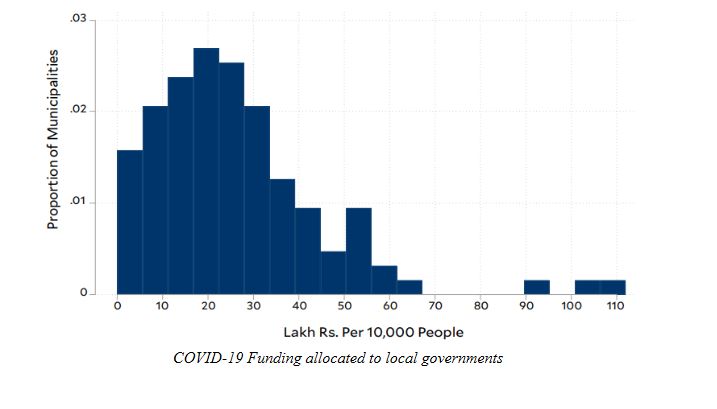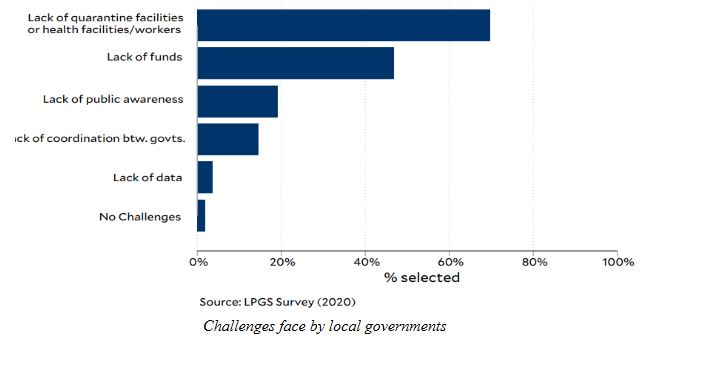Pande and coauthors in myRepublica: We Recommend a New Funding Model to Address Covid-19 and Floods

Nepal's new federal structure delegates many administrative decisions to the local level. A large-scale survey of provincial and local government officials suggests that a data-driven approach to funding allocations can help address challenges posed by the Covid-19 pandemic, floods, and lean seasons.
Nepal’s new federal institutions are up against a formidable set of disasters: the COVID-19 pandemic and severe floods, along with the imminent lean season. The federal, provincial, and local levels of government need to coordinate to rise to these challenges. A large-scale survey of provincial and local government officials suggests that a data-driven approach to allocating funds can help.
The new federal structure delegates many administrative decisions to the local level: public health is a shared responsibility across governmental spheres, but primary healthcare and sanitation are exclusively local government functions. Municipal and ward officials, therefore, have a major role to play in mitigating the human and economic damage created by the combined disasters: they are in charge of getting food to the needy, managing quarantine centers, and implementing testing and tracking schemes. These responsibilities will only grow more important in the coming weeks and months, as COVID-19 numbers rise and the floods continue.
However, this allocation of administrative authority to local governments is out of sync with their financial authority. Despite having primary responsibility for several COVID-19 responses, local governments have to depend on funds flowing from the provincial and federal government to have the resources to respond, and also borrow from within their budget which might compromise expenditure under those headings such as education and regular health.

Assessing local governments’ readiness for the challenges they are facing, therefore, requires knowledge on whether relief funds are getting to the places that need them most.
Our team of researchers from the Governance Lab, the London School of Economics, Yale University, and Nepal Administrative Staff College conducted a survey of provincial officials across seven provinces, mayors and chairpersons, deputy mayors and vice-chairpersons, and chief administrative officers across 115 local governments to assess dynamics of COVID-19 response at provincial and local levels. These data, collected in June prior to the end of nationwide lockdown, reveal three key issues and inequities with local funding.

First, local governments roundly report a lack of adequate funds as a major challenge. They largely rely on their own budgets for COVID-19 related health activities, which are not sufficient.
Second, the local governments facing the most serious outbreaks have the least amount of funding to respond. This mismatch arises, in part, because high COVID-19 caseload areas are in Terai where local governments had already exhausted much of their annual disaster funds on flood relief. On the other hand, Himalayan regions, which largely use these annual funds for less-frequent disasters (such as earthquakes and landslides) report accessing roughly 2.5 times more disaster funding for COVID-19 than Terai regions. Indeed, there is substantial dispersion in the amount of funding available: local government officials report an average funding availability of 83 lakh rupees (261 rupees per capita). This ranges across local governments from Rs. 60 and 504 per person.
Third, provincial and federal authorities target funds to high COVID-19 areas by bypassing local governments and directly allocating funds to hospitals and district bodies. Local governments, however, continue to remain responsible for multiple federal government orders.
All indications are that these problems will persist without major action. For example, as of August 9, 100 local governments – making up around one seventh of all of Nepal’s local governments – have yet to present their budgets for FY 2020/21, according to a data released by the Ministry of Federal Affairs and General Administration (MoFAGA). This means that their funds will not be replenished. As per Nepal’s law, governments cannot spend money without approving financial bills from their respective assemblies. These budgets are more than a month overdue, and concerningly, the highest number of unsubmitted budgets are from the Terai.

While COVID-19, flooding, and the onset of the lean season present challenges, the specific problem of fund allocation may be solvable. Our research suggests that a need-based funding model can help. Present and anticipated COVID-19 caseloads should regularly inform additional budget allocations to local governments. Local governments with higher caseloads require access to additional funds for broader public health activities such as contact tracing programs. Accordingly, budget allocations for local governments could be regularly updated based on COVID-19 caseload, both present and anticipated.
The case of quarantine financing is promising. We see that federal funds for quarantine management do align well with caseloads. Provincial and federal governments should develop transparent and justifiable criteria for allocating their funds across different bodies at the local level – local government, district committees, and hospitals/health facilities.
Local governments also need support to build the capacity to submit their budgets and to build testing and contact tracing programs. Provincial and federal authorities should develop needs-based criteria for allocating their health funds across local governments, district committees, and hospitals/health facilities – and the process should be transparent to all stakeholders.
This was first published September 17th, 2020 on MyRepublica.NagarikNetwork.com.